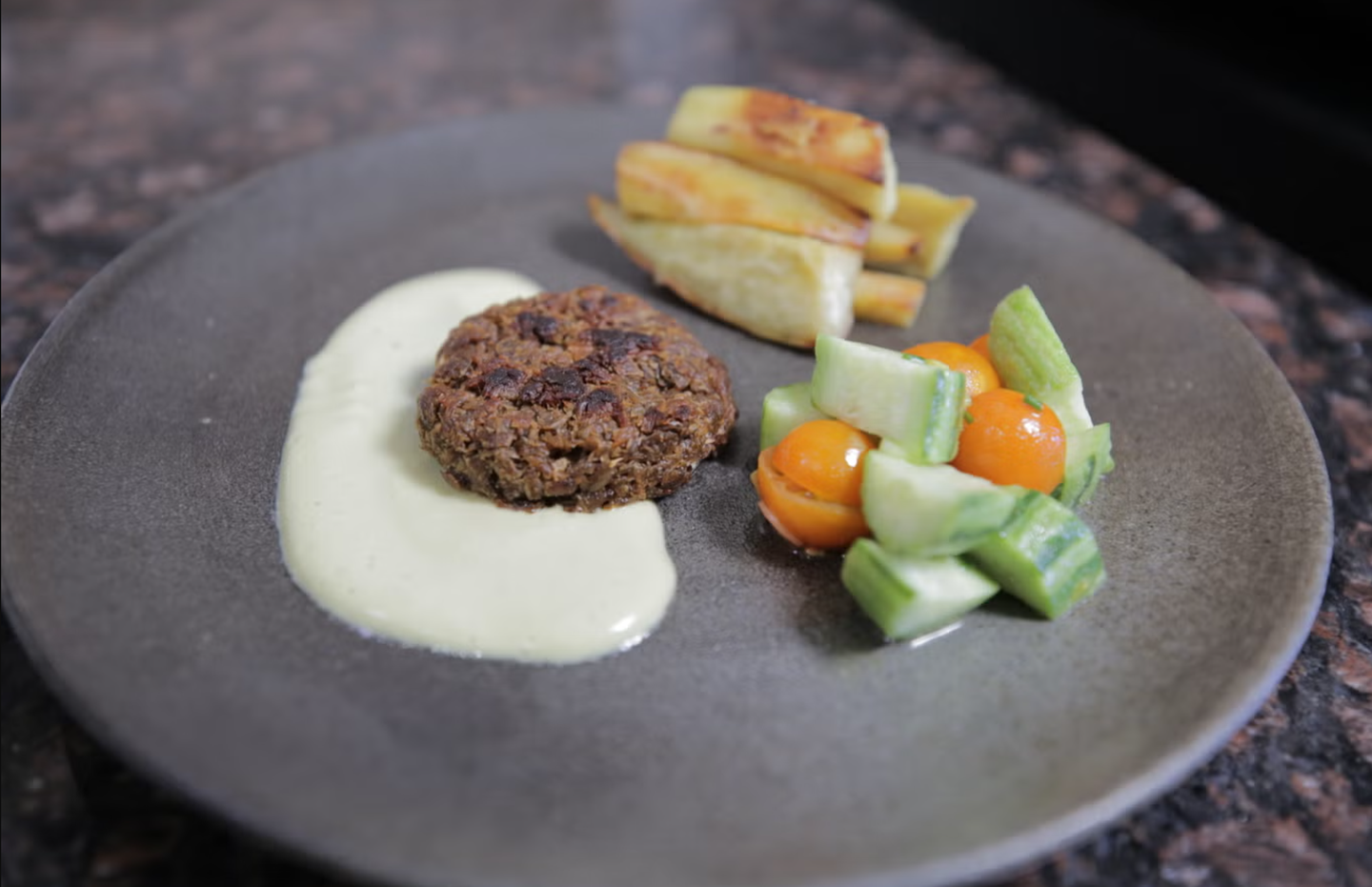Chef uses fungi to transform food waste into gourmet delights
This passion, merging the worlds of culinary arts and scientific research, has led to innovative collaborations and groundbreaking discoveries.

A sauteed patty composed of soy pulp innoculated with Neurospora mold and left to ferment for several days. UC Berkeley postdoctoral fellow Vayu Hill-Maini prepared and cooked the patty, plating it with a cashew cream sauce, baked yams and a fresh cherry tomato and cucumber salad. (CREDIT:
Vayu Hill-Maini, UC Berkeley)
Chef-turned-chemist Vayu Hill-Maini has dedicated his career to transforming food waste into gourmet creations using fungi, specifically the Neurospora mold. This passion, merging the worlds of culinary arts and scientific research, has led to innovative collaborations and groundbreaking discoveries.
One of Hill-Maini’s most notable collaborations is with Rasmus Munk, the head chef and co-owner of the Michelin two-star restaurant Alchemist in Copenhagen. Munk was so inspired by Hill-Maini’s work that he created a dessert featuring Neurospora mold grown on rice, a dish that vividly demonstrates the potential of using fungi to repurpose food waste into something both delicious and sustainable.
Hill-Maini’s journey into the world of Neurospora began more than two years ago, when he teamed up with the chefs at Blue Hill at Stone Barns, a Michelin two-star restaurant in Pocantico Hills, New York. Together, they have experimented with growing the mold on various grains and pulses, including the leftover pulp from oat milk production.
If you visit Blue Hill, you might find yourself enjoying a patty of grain covered with orange Neurospora, or perhaps a slice of moldy bread—Neurospora grown on rice bread, which, when fried, tastes remarkably like a toasted cheese sandwich.
But Hill-Maini’s ambitions extend far beyond creating novel dishes for high-end restaurants. As a Miller postdoctoral fellow at the University of California, Berkeley, he is deeply invested in understanding the full potential of Neurospora intermedia, a fungus traditionally used in Indonesia to make oncom, a food made from soy pulp.
Hill-Maini’s goal is to adapt this fungus to tackle the issue of food waste in the Western world, where it could be used to convert a variety of agricultural by-products into edible and appealing foods.
The scale of food waste in the U.S. is staggering. According to Hill-Maini, about a third of all food produced in the country is wasted, and this waste goes far beyond what’s discarded in households. “Our food system is very inefficient,” Hill-Maini explains. “What happens to all the grain involved in the brewing process, all the oats that didn’t make it into oat milk, or the soybeans that didn’t make it into soy milk? It’s thrown out.”
Related Stories
Hill-Maini’s introduction to the potential of food waste came when a fellow chef from Indonesia introduced him to oncom. This fermented food struck him as a prime example of how waste could be converted into a valuable food source. “This food is a beautiful example of how we can take waste, ferment it, and make human food from it,” Hill-Maini says. “So let’s learn from this example, study this process in detail, and maybe there are broader lessons we can draw about how to tackle the general challenge of food waste.”
Inspired by Hill-Maini’s vision, Blue Hill has recently installed an incubator and tissue culture hood in its test kitchen, allowing them to explore fungal foods more deeply. Previously, Blue Hill’s chef in charge of special projects, Luzmore, would send various substrates to Hill-Maini’s lab at the Joint BioEnergy Institute (JBEI) in Emeryville, California, where Neurospora would transform them into something entirely new.
Luzmore has tasted many of Hill-Maini’s experiments, with a personal favorite being a dish made from stale rice bread. “It’s incredibly delicious. It looks and tastes like you grated cheddar onto bread and toasted it,” Luzmore says. “It’s a very clear window into what can be done with this.”
Cultures worldwide have long embraced foods transformed by fungi, from grain turned into alcohol by yeast to milk curds becoming blue cheese through Penicillium mold. However, oncom is unique in being made from waste food. Developed by native Javanese long ago, it remains one of the few, if not the only, human foods fermented solely by Neurospora mold. But that may change soon.
Hill-Maini has conducted extensive research into the genetics of Neurospora intermedia strains that transform soy milk waste into oncom. His findings, published in the journal Nature Microbiology, reveal how this fungus can chemically alter 30 different types of plant waste, opening up new possibilities for sustainable food production.
“In the last few years, fungi and molds have caught the public eye for their health and environmental benefits, but a lot less is known about the molecular processes that these fungi carry out to transform ingredients into food,” Hill-Maini explains. “Our discovery, I think, opens our eyes to these possibilities and unlocks further the potential of these fungi for planetary health and planetary sustainability.”
The process of creating oncom is surprisingly fast. In West Java, where oncom is a traditional food, it comes in two varieties: red oncom, made by fermenting soy pulp left over from making tofu, and black oncom, grown on the leftover pressings from making peanut oil. Both varieties are used in a range of dishes, from stir-fries to dumpling fillings.
Hill-Maini found that Neurospora fungi can transform indigestible plant material—such as polysaccharides like pectin and cellulose—into digestible, nutritious food in just 36 hours. “The fungus readily eats those things and in doing so makes this food and also more of itself, which increases the protein content,” he says. “You actually have a transformation in the nutritional value, a change in the flavor profile, and finally, some beneficial metabolites are produced in high amounts.”
Yeast, another fungus, is famous for its ability to ferment grains and fruits into alcohol. However, the fungus that produces oncom operates differently. It’s a filamentous fungus, spreading and growing as filaments similar to those found in the soil where mushrooms are produced. Unlike mushrooms, the oncom fungus doesn’t produce fruiting bodies; instead, it functions more like the mold that grows on spoiled food. But unlike spoilage molds, the Penicillium mold that makes blue cheese and the koji mold that creates soy sauce, miso, and sake, raise bland foods to new heights of flavor.
Oncom is distinctive in that it’s one of the only fungal foods grown on food by-products. In his research, Hill-Maini demonstrated that Neurospora intermedia can grow on a wide variety of agricultural waste products—from sugar cane bagasse to almond hulls—without producing the toxins that can accumulate in other fungi.
His genetic analysis also revealed that the Neurospora strains responsible for making red oncom are primarily N. intermedia, found consistently in samples from West Java. “What was very clear is, wow, this fungus is probably dominant and maybe sufficient for making this food possible, growing on the cellulose-rich soy milk waste and making the food in 36 hours,” Hill-Maini says.
However, black oncom, which is also popular in Java, is produced using a different range of fungi, primarily Rhizopus species, along with various bacteria. Tempeh, another traditional Javanese food, is similarly produced by fermenting soybeans with Rhizopus mold.
Further genetic analysis showed that there are two distinct types of Neurospora: wild strains found worldwide and strains that have adapted specifically to the agricultural waste generated by humans. “What we think has happened is that there’s been a domestication as humans started generating waste or by-products, and it created a new niche for Neurospora intermedia,” Hill-Maini explains. “And through that, probably the practice of making oncom emerged.”
While Neurospora has proven to be effective at converting waste into food, the big question remains: does it taste good? Hill-Maini was particularly concerned with this question. “The most important thing, especially for me as a chef, is, ‘Is it tasty?’ Sure, we can grow it on all these different things, but if it doesn’t have sensory appeal, if people don’t perceive it positively outside of a very specific cultural context, then it might be a dead end,” he says.
In collaboration with Munk at Alchemist, Hill-Maini conducted taste tests, presenting red oncom to 60 people who had never tried it before. The feedback was overwhelmingly positive, with participants describing the flavor as earthy, nutty, and mushroomy, consistently rating it above six out of nine on a sensory scale. The chefs at Alchemist also experimented with growing Neurospora on various nuts, including peanuts, cashews, and pine nuts, all of which were well-received.
Hill-Maini is excited about the potential for Neurospora to be used in a variety of culinary applications. Munk has already added a Neurospora dessert to Alchemist’s menu: a bed of jellied plum wine topped with unsweetened rice custard inoculated with Neurospora and fermented for 60 hours, served cold with a drop of lime syrup made from roasted leftover lime peel.
“We experienced that the process changed the aromas and flavors in quite a dramatic way—adding sweet, fruity aromas,” Munk says. “I found it mind-blowing to suddenly discover flavors like banana and pickled fruit without adding anything besides the fungi itself.”
This dessert is just one example of how Neurospora could revolutionize the way we think about food waste. Hill-Maini and Munk have also published their findings on edible Neurospora fermentations in the International Journal of Gastronomy and Food Science, where they reported on taste tests of oncom and oncom-like foods grown on substrates other than soy.
Munk sees this as just the beginning, expressing excitement about what other culinary applications this research could lead to, particularly using other waste products from the food industry. Recently, Munk launched a food innovation center called Spora, which focuses on upcycling side-streams from the food industry and developing new protein sources.
Hill-Maini’s passion for cooking began at a young age, growing up in a culturally diverse household. His mother, of Indian descent from Kenya, introduced Swedes to Indian spices and cooking techniques
Note: Materials provided above by The Brighter Side of News. Content may be edited for style and length.
Like these kind of feel good stories? Get The Brighter Side of News' newsletter.



